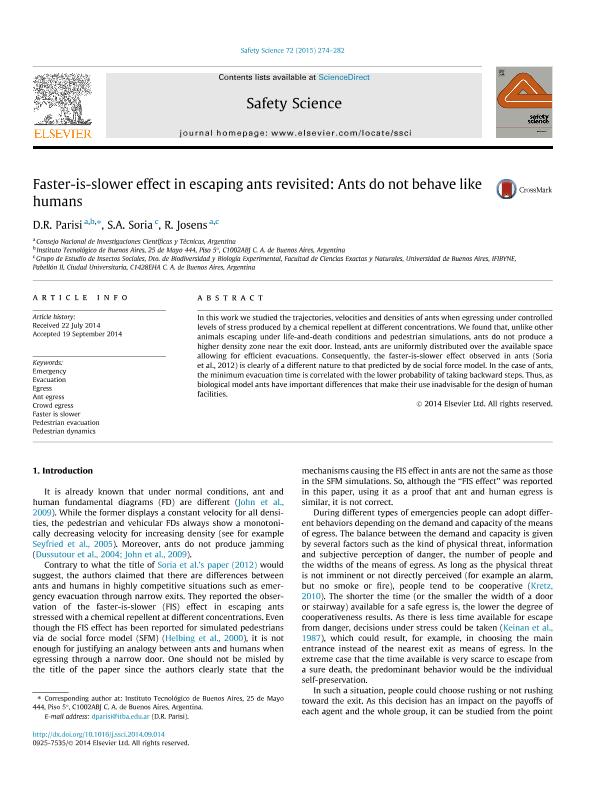Mostrar el registro sencillo del ítem
dc.contributor.author
Parisi, Daniel Ricardo

dc.contributor.author
Soria, Sabrina Andrea

dc.contributor.author
Josens, Roxana Beatriz

dc.date.available
2017-07-19T19:36:00Z
dc.date.issued
2015-02
dc.identifier.citation
Parisi, Daniel Ricardo; Soria, Sabrina Andrea; Josens, Roxana Beatriz; Faster-is-slower effect in escaping ants revisited: Ants do not behave like humans; Elsevier; Safety Science; 72; 2-2015; 274-282
dc.identifier.issn
0925-7535
dc.identifier.uri
http://hdl.handle.net/11336/20948
dc.description.abstract
In this work we studied the trajectories, velocities and densities of ants when egressing under controlled levels of stress produced by a chemical repellent at different concentrations. We found that, unlike other animals escaping under life-and-death conditions and pedestrian simulations, ants do not produce a higher density zone near the exit door. Instead, ants are uniformly distributed over the available space allowing for efficient evacuations. Consequently, the faster-is-slower effect observed in ants (Soria et al., 2012) is clearly of a different nature to that predicted by de social force model. In the case of ants, the minimum evacuation time is correlated with the lower probability of taking backward steps. Thus, as biological model ants have important differences that make their use inadvisable for the design of human facilities.
dc.format
application/pdf
dc.language.iso
eng
dc.publisher
Elsevier

dc.rights
info:eu-repo/semantics/openAccess
dc.rights.uri
https://creativecommons.org/licenses/by-nc-sa/2.5/ar/
dc.subject
Emergency
dc.subject
Evacuation
dc.subject
Egress
dc.subject
Ant Egress
dc.subject
Crowd Egress
dc.subject
Faster is Slower
dc.subject
Pedestrian Evacuation
dc.subject
Pedestrian Dynamics
dc.subject.classification
Otras Ciencias Físicas

dc.subject.classification
Ciencias Físicas

dc.subject.classification
CIENCIAS NATURALES Y EXACTAS

dc.title
Faster-is-slower effect in escaping ants revisited: Ants do not behave like humans
dc.type
info:eu-repo/semantics/article
dc.type
info:ar-repo/semantics/artículo
dc.type
info:eu-repo/semantics/publishedVersion
dc.date.updated
2017-07-11T19:27:18Z
dc.journal.volume
72
dc.journal.pagination
274-282
dc.journal.pais
Países Bajos

dc.journal.ciudad
Ámsterdam
dc.description.fil
Fil: Parisi, Daniel Ricardo. Instituto Tecnológico de Buenos Aires; Argentina. Consejo Nacional de Investigaciones Científicas y Técnicas; Argentina
dc.description.fil
Fil: Soria, Sabrina Andrea. Universidad de Buenos Aires. Facultad de Ciencias Exactas y Naturales. Departamento de Biodiversidad y Biología Experimental. Laboratorio del Grupo de Estudio de Insectos Sociales; Argentina. Consejo Nacional de Investigaciones Científicas y Técnicas; Argentina
dc.description.fil
Fil: Josens, Roxana Beatriz. Universidad de Buenos Aires. Facultad de Ciencias Exactas y Naturales. Departamento de Biodiversidad y Biología Experimental. Laboratorio del Grupo de Estudio de Insectos Sociales; Argentina. Consejo Nacional de Investigaciones Científicas y Técnicas; Argentina
dc.journal.title
Safety Science

dc.relation.alternativeid
info:eu-repo/semantics/altIdentifier/url/http://www.sciencedirect.com/science/article/pii/S0925753514002240
dc.relation.alternativeid
info:eu-repo/semantics/altIdentifier/doi/http://dx.doi.org/10.1016/j.ssci.2014.09.014
dc.relation.alternativeid
info:eu-repo/semantics/altIdentifier/url/https://arxiv.org/abs/1410.5261
Archivos asociados
